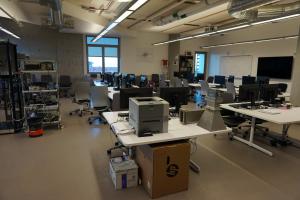Bloom Optical Lab
Prof. Bloom's lab, located on the second floor of Campbell Hall, was started in summer 2005 with startup funds. In the following months, student Onsi Fakhouri and Bloom designed and built a next-generation 10 micron all-sky imager which was later used to take meteorology data at Mt. Hopkins Observatory. Later, they built the first parallelized Mac OS computing cluster in the Astronomy Department, that hosted over 15 active users (from undergraduates to professors). The lab eventually housed several undergraduates doing research projects in Bloom's group using a prototype of a distributed Mac OS network. The lab is currently working on developing new projects.
Breakthrough Listen
Located in 339 Campbell Hall, this lab supports GHz bandwidth, real-time signal processing, signal detection and scientific data analysis for the Breakthrough Listen Initiative, the most powerful, comprehensive and intensive search ever undertaken for signs of intelligent life beyond Earth. From the lab, researchers are able to conduct remote observations with the Green Bank Radio Telescope in West Virginia, the Parkes Radio Telescope in Australia and the Automated Planet Finder Telescope at Lick Observatory in San Jose, CA.
Cryo Lab
The Cryo-Lab, overseen by the Radio Astronomy Lab group, is currently working on developing the framework for new projects that include cryogenics, RF testing, and beam pattern measurements.
Graham Lab
Lawrence Berkeley National Laboratory (LBL)
Lawrence Berkeley National Laboratory (LBL) has been a leader in science and engineering research for more than 70 years. Located on a 200 acre site in the hills above the University of California's Berkeley campus, LBL operates with an annual budget of more than $500 million (FY2004) and a staff of about 3,800 employees, including more than 500 students.
Berkeley Lab conducts unclassified research across a wide range of scientific disciplines with key efforts in fundamental studies of the universe; quantitative biology; nanoscience; new energy systems and environmental solutions; and the use of integrated computing as a tool for discovery. Founded on the belief that scientific research is best done through teams of individuals with different fields of expertise working together, LBL has yielded rich dividends in basic knowledge and applied technology, and a profusion of awards. Today there are 10 Nobel Laureates associated with LBL.
Parsons Lab
The Parson’s Lab supports scientific research and instrumentation addressing the large scale structure and evolution of the early Universe. The Lab has supported the operations and scientific output of the Precision Array Probing the Epoch of Reionization (PAPER) located in the Karoo region of South Africa and is currently designing and deploying the Hydrogen Epoch of Reionization Array (HERA) at the same location. The Lab focuses on statistical measurements of the sky’s spatial “power spectrum” by measuring bulk parameters of the red-shifted hydrogen line.
RAL Digital Lab
The RAL Digital Lab designs, tests, implements and supports cutting edge digital systems for radio astronomy. As one of the principle and initial developers of the open-source based Collaboration for Astronomical Signal Processing and Electronics Research (CASPER), the Digital Lab has been leading the development and support of world-class instruments around the world.
RAL Electronics Lab
The RAL Electronics Lab (‘E-lab’) houses general test and measurement equipment, electronics fabrication tools, basic electronics parts and design software to design, fabricate and test telescope receiver and control system. The E-lab can support design, fabrication and testing from base-band to 40 GHz and mostly focusses on the systems behind the front-end. The E-lab also designs and implements control and support systems for telescopes as a full integrated system. The E-lab has designed systems for every telescope system that has been developed as part of the Radio Astronomy Lab’s 50 year history, including the 85’, BIMA, ATA, CARMA, PAPER and HERA.
RAL Fabrication Lab
The RAL Fabrication Lab (‘fab-lab’) houses general fabrication and tools and machinery to support prototyping and limited builds of telescope systems.
Space Sciences Lab
The Space Sciences Laboratory aims to stimulate faculty and student participation in space research by supporting interdisciplinary research in the physical, biological, engineering, and social sciences. The lab has been and continues to be involved with projects like Cassini Ion and Natural Mass Spectrometer (INMS) and the Supernova Acceleration Probe (SNAP) as well as many, many others. The Laboratory is located in a wooded site with a view of the bay which is one of the most beautiful on the Berkeley campus.

The David D. Cudaback Undergraduate Astronomy Lab
Undergraduate Astro Lab is located in 541 Campbell Hall. It offers computer resources for Astronomy students and operates the telescopes on the roof of Campbell Hall and at Leuschner Observatory. It is named in honor of beloved Astronomer and educator David D. Cudaback.
